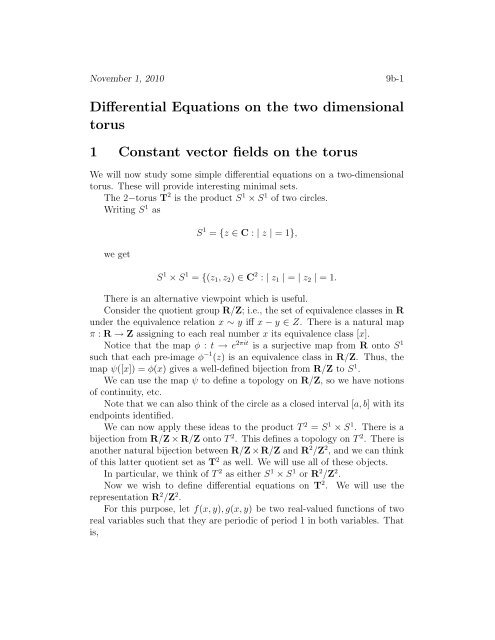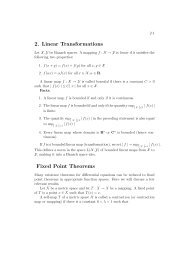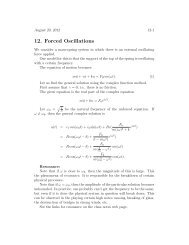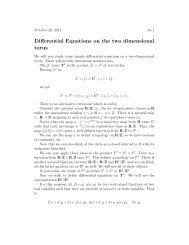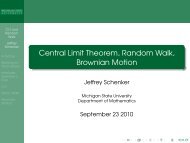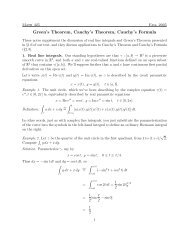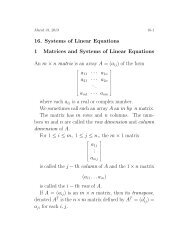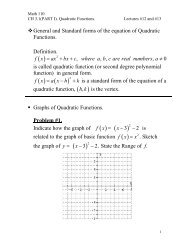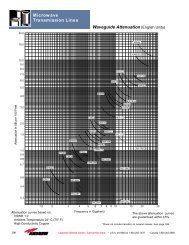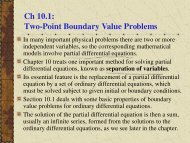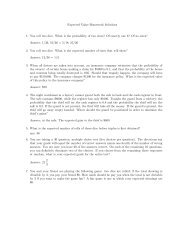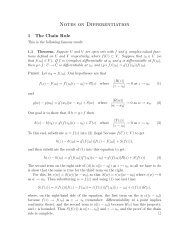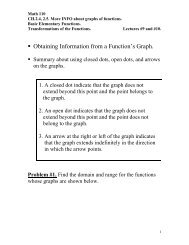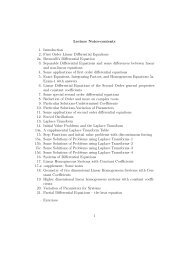Differential Equations on the two dimensional torus 1 Constant ...
Differential Equations on the two dimensional torus 1 Constant ...
Differential Equations on the two dimensional torus 1 Constant ...
Create successful ePaper yourself
Turn your PDF publications into a flip-book with our unique Google optimized e-Paper software.
November 1, 2010 9b-1<str<strong>on</strong>g>Differential</str<strong>on</strong>g> <str<strong>on</strong>g>Equati<strong>on</strong>s</str<strong>on</strong>g> <strong>on</strong> <strong>the</strong> <strong>two</strong> dimensi<strong>on</strong>al<strong>torus</strong>1 C<strong>on</strong>stant vector fields <strong>on</strong> <strong>the</strong> <strong>torus</strong>We will now study some simple differential equati<strong>on</strong>s <strong>on</strong> a <strong>two</strong>-dimensi<strong>on</strong>al<strong>torus</strong>. These will provide interesting minimal sets.The 2−<strong>torus</strong> T 2 is <strong>the</strong> product S 1 × S 1 of <strong>two</strong> circles.Writing S 1 aswe getS 1 = {z ∈ C : | z | = 1},S 1 × S 1 = {(z 1 , z 2 ) ∈ C 2 : | z 1 | = | z 2 | = 1.There is an alternative viewpoint which is useful.C<strong>on</strong>sider <strong>the</strong> quotient group R/Z; i.e., <strong>the</strong> set of equivalence classes in Runder <strong>the</strong> equivalence relati<strong>on</strong> x ∼ y iff x − y ∈ Z. There is a natural mapπ : R → Z assigning to each real number x its equivalence class [x].Notice that <strong>the</strong> map φ : t → e 2πit is a surjective map from R <strong>on</strong>to S 1such that each pre-image φ −1 (z) is an equivalence class in R/Z. Thus, <strong>the</strong>map ψ([x]) = φ(x) gives a well-defined bijecti<strong>on</strong> from R/Z to S 1 .We can use <strong>the</strong> map ψ to define a topology <strong>on</strong> R/Z, so we have noti<strong>on</strong>sof c<strong>on</strong>tinuity, etc.Note that we can also think of <strong>the</strong> circle as a closed interval [a, b] with itsendpoints identified.We can now apply <strong>the</strong>se ideas to <strong>the</strong> product T 2 = S 1 × S 1 . There is abijecti<strong>on</strong> from R/Z × R/Z <strong>on</strong>to T 2 . This defines a topology <strong>on</strong> T 2 . There isano<strong>the</strong>r natural bijecti<strong>on</strong> between R/Z × R/Z and R 2 /Z 2 , and we can thinkof this latter quotient set as T 2 as well. We will use all of <strong>the</strong>se objects.In particular, we think of T 2 as ei<strong>the</strong>r S 1 × S 1 or R 2 /Z 2 .Now we wish to define differential equati<strong>on</strong>s <strong>on</strong> T 2 . We will use <strong>the</strong>representati<strong>on</strong> R 2 /Z 2 .For this purpose, let f(x, y), g(x, y) be <strong>two</strong> real-valued functi<strong>on</strong>s of <strong>two</strong>real variables such that <strong>the</strong>y are periodic of period 1 in both variables. Thatis,
November 1, 2010 9b-2f(x + 1, y + 1) = f(x, y), g(x + 1, y + 1) = g(x, y), ∀x, y.The planar vector field X(x, y) = (f(x, y), g(x, y)) is a map from R 2 →R 2 . The periodicity c<strong>on</strong>diti<strong>on</strong>s imply that it induces a well-defined map fromR 2 /Z 2 to R 2 . We call this a vector field <strong>on</strong> <strong>the</strong> <strong>torus</strong> T 2 . The associatedsystem of differential equati<strong>on</strong>sẋ = f(x, y)ẏ = g(x, y)is called a differential equati<strong>on</strong> <strong>on</strong> T 2 .The soluti<strong>on</strong>s (or orbits) are obtained by taking <strong>the</strong> orbits in R 2 andprojecting <strong>the</strong>m down to T 2 .Let us take a simple example.C<strong>on</strong>sider <strong>the</strong> c<strong>on</strong>stant vector field in R 2X(x, y) = ω 1 ∂ x + ω 2 ∂ y ,where ω 1 , ω 2 are positive real numbers.The associated system of differential equati<strong>on</strong>s isẋ = ω 1ẏ = ω 2(1)The periodicity c<strong>on</strong>diti<strong>on</strong>s are obviously satisfied, so we get a differentialequati<strong>on</strong> <strong>on</strong> T 2 . This is called <strong>the</strong> c<strong>on</strong>stant or linear vector field <strong>on</strong> T 2 .Let’s us c<strong>on</strong>sider its orbits.The soluti<strong>on</strong>s to (1) in R 2 are <strong>the</strong> linesx(t) = ω 1 t + c 1 , y(t) = ω 2 t + c 2 .Each such line has slope ω 2ω 1and passes through <strong>the</strong> point (c 1 , c 2 ).On <strong>the</strong> <strong>torus</strong> T 2 we simply take (x(t), y(t)) mod 1.We have <strong>two</strong> main cases:1. 2ω 1is rati<strong>on</strong>al. Write it as 2ω 1= p in lowest terms with p, q positiveqintegers.C<strong>on</strong>sider <strong>the</strong> orbit γ 0 in R 2 through (0, 0) (i.e., c 1 = c 2 = 0).
November 1, 2010 9b-3The soluti<strong>on</strong> in R 2 has <strong>the</strong> form( ) px(t) = ω 1 t, y(t) = ω 1 tqLet π : R 2 → T 2 denote <strong>the</strong> can<strong>on</strong>ical projecti<strong>on</strong>.When t = q/ω 1 , we have x(t) = q, y(t) = p, so <strong>the</strong> projecti<strong>on</strong> π(γ 0 ) = γinto T 2 is a closed curve (topological circle) in T 2 .Since all <strong>the</strong> soluti<strong>on</strong>s are vertical tranlates of γ 0 we have that allsoluti<strong>on</strong>s in T 2 are periodic of <strong>the</strong> same period.2. ω 2ω 1is irrati<strong>on</strong>al.This case is more interesting. We will show that every orbit in T 2 isdense in T 2 . Hence, all of T 2 is a minimal set.Let us show that <strong>the</strong> orbit through (0, 0) is dense in T 2 . The analogousstatement for o<strong>the</strong>r orbits is similar.C<strong>on</strong>sider <strong>the</strong> circle S 1 = π({x = 0}).There is a first return map F : S 1 → S 1 (also called Poincaré map)obtained by taking a point (0, y) and taking <strong>the</strong> point (1, F (y)) where<strong>the</strong> orbit through (0, y) hits <strong>the</strong> line {x = 1}.Let us compute F .The orbit through (0, y) is {(ω 1 t, ω 2 t + y), t ∈ R}.We getHence,ω 1 t = 1ω 2 t + y = F (y).t = 1/ω 1 , F (y) = y + ω 2 /ω 1So, letting α = ω 2ω 1we get that F (y) = y + α (mod 1).To show that <strong>the</strong> orbits of X are dense, it suffices to show that <strong>the</strong>iterates {F n (y), n ∈ Z} are dense mod 1
November 1, 2010 9b-4This is <strong>the</strong> number <strong>the</strong>oretic statement: for α irrati<strong>on</strong>al, and<strong>the</strong>nA = {nα + m : n ∈ Z, m ∈ Z},This elementary fact is proved as follows.(a) A is clearly an additive subgroup of R.A is dense in R. (2)(b) To show that A is dense, it suffices to show that 0 is an accumulati<strong>on</strong>point of A.(c) For this latter fact, for each n ≥ 0, let m n ∈ Z be such thatx n = nα + m n ∈ [0, 1). Since α is irrati<strong>on</strong>al, <strong>the</strong> numbers x n areall distinct. Since [0, 1] is compact, <strong>the</strong>re is a subsequence x ni of(x n ) which c<strong>on</strong>verges. In particular, if ɛ > 0 is arbitrary, <strong>the</strong>re arepoints x n1 , x n2 such that| x n1 − x n2 | < ɛ.But <strong>the</strong>n this difference x n1 − x n2 is in A ⋂ (−ɛ, ɛ). Since, ɛ isarbitrary, we have that 0 is an accumulati<strong>on</strong> point of A as required.Let us now give an applicati<strong>on</strong> of <strong>the</strong>se ideas.C<strong>on</strong>sider <strong>the</strong> mass spring system whose equati<strong>on</strong> ismẍ + kx = 0where m is <strong>the</strong> mass of an object suspended vertically by a spring,k > 0 is <strong>the</strong> spring c<strong>on</strong>stant, and x = 0 represents <strong>the</strong> equilibriumpositi<strong>on</strong>.√Let ω = k. The associated first order planar system can be writtenmẋ = −ω yẏ = ω x(3)
November 1, 2010 9b-5Let us write this system (3) in polar coordinates.We havex = rcos(θ), y = rsin(θ)ẋ = ṙcos(θ) − rsin(θ) ˙θẏ = ṙsin(θ) + rcos(θ) ˙θ(4)So, we see that <strong>the</strong> simple polar coordinate systemṙ = 0˙θ = ω(5)is equivalent to (4).The soluti<strong>on</strong>s off (0, 0) arer = c > 0, θ(t) = ω t + θ 0 .Hence, <strong>the</strong> orbits in <strong>the</strong> plane off (0, 0) c<strong>on</strong>sist of <strong>the</strong> circles r = c and<strong>the</strong> moti<strong>on</strong> has c<strong>on</strong>stant rotati<strong>on</strong>al speed ω with period 2π ω .Now, c<strong>on</strong>sider <strong>two</strong> uncoupled springs whose equati<strong>on</strong>s in R 4 becomex˙1 = −ω 1 y 1y˙1 = ω x 1(6)x˙2 = −ω 2 y 2y˙2 = ω 2 x 2Using polar coordinates (r 1 , θ 1 , r 2 , θ 2 ) in R 4 in <strong>the</strong> obvious way, we get<strong>the</strong> equivalent equati<strong>on</strong>sr˙1 = 0θ˙1 = ω 1(7)r˙2 = 0θ˙2 = ω 2Hence all soluti<strong>on</strong>s in R 4 off <strong>the</strong> uni<strong>on</strong> of <strong>the</strong> <strong>two</strong> subspaces R 2 ×{(0, 0} ⋃ {0, 0}×R 2 lie <strong>on</strong> <strong>two</strong> dimensi<strong>on</strong>al tori r 1 = c 1 , r 2 = c 2 , and <strong>the</strong> moti<strong>on</strong> <strong>on</strong> each is ac<strong>on</strong>stant vector field. If ω 2 /ω 1 is rati<strong>on</strong>al, <strong>the</strong>n all <strong>the</strong>se orbits are periodic,and if ω 2 /ω 1 is irrati<strong>on</strong>al, <strong>the</strong>n all <strong>the</strong>se tori are minimal sets.
November 1, 2010 9b-62 Gradient vector fields <strong>on</strong> <strong>the</strong> <strong>torus</strong>To specify a gradient vector field <strong>on</strong> <strong>the</strong> <strong>two</strong> dimensi<strong>on</strong>al <strong>torus</strong>, we need toc<strong>on</strong>sider smooth potential functi<strong>on</strong>s <strong>on</strong> <strong>the</strong> <strong>torus</strong> T 2 = R 2 /Z 2 . These aresmooth functi<strong>on</strong>s ψ(x, y) such thatψ(x + 1, y + 1) = ψ(x, y) for all (x, y) ∈ R 2 .From <strong>the</strong> <strong>the</strong>ory of Fourier series, we can write such functi<strong>on</strong>s as sums∞∑ψ(x, y) = a k cos(2πkx) + b k sin(2πk)k=0The simplest such examples are <strong>the</strong> trig<strong>on</strong>ometric polynomialsN∑ψ N (x, y) = a k cos(2πkx) + b k sin(2πk)k=0for a positive integer N.Givena functi<strong>on</strong> ψ(x, y) with ψ(x + 1, y + 1) = ψ(x, y), we obtain itsgradient vector field byX(x, y) = (∂ x ψ(x, y), ∂ y ψ(x, y))We wish to give a simple geometric interpretati<strong>on</strong> of this in a special case.First, we recall some c<strong>on</strong>cepts about surfaces of revoluti<strong>on</strong> in R 3 .Let (X, Y, Z) denote <strong>the</strong> coordinates of a point in R 3 .Let I = (a, b) be an open interval in R with a < b.C<strong>on</strong>sider a C r parametrized curve η : I → R 3 in <strong>the</strong> XY -plane given bysuch thatandη(t) = (X(t), Y (t), 0)inf | X(t) |) > 0t∈Iinf |t∈I X′ (t) 2 + Y ′ (t) 2 | > 0
November 1, 2010 9b-7with r ≥ 1.Thus, <strong>the</strong> image of η is disjoint from <strong>the</strong> Y − axis, and <strong>the</strong> tangent vectorsto η never vanish.The surface obtained by revolving η about <strong>the</strong> Y −axis can be parametrizedbyγ(t, θ) = (X(t)cos(2πθ), Y (t), X(t)sin(2πθ))with 0 < θ < 1).Thus, <strong>the</strong> map γ : (a, b)×(0, 1) → R 3 is a C r embedding from (a, b)×(0, 1)into R 3 . Its image is <strong>the</strong> surface of revoluti<strong>on</strong> determined by η and <strong>the</strong> Y −axis.Next, c<strong>on</strong>sider <strong>the</strong> open unit box in R 2 given by (0, 1) × (0, 1). We usethis to parametrize an open dense set of a <strong>torus</strong> of revoluti<strong>on</strong> in R 3 as follows.Let 0 < r < R be <strong>two</strong> positive real numbers.C<strong>on</strong>sider <strong>the</strong> embedding η from (0, 1) into <strong>the</strong> X − Y −plane given byη(t) = (R + r cos(2πt), r sin(2πt), 0) = (X(t), Y (t), 0)This maps (0, 1) <strong>on</strong>to <strong>the</strong> circle{(X, Y, 0) : (X − R) 2 + Y 2 = r 2 }with a point removed.Using this to parametrize <strong>the</strong> surface obtained by revolving η about <strong>the</strong>Y −axis, we get <strong>the</strong> map Φ : (0, 1) × (0, 1) → R 3 defined byΦ(t, θ) = ((R + rcos(2πt)cos(2πθ), r sin(2πt), (R + rcos(2πt)sin(2πθ)).The image is an open <strong>torus</strong> of revoluti<strong>on</strong> with <strong>two</strong> circles removed. Theimage is dense in <strong>the</strong> <strong>torus</strong> of revoluti<strong>on</strong>.C<strong>on</strong>sider <strong>the</strong> height functi<strong>on</strong> h(X, Y, Z) = Z from R 3 to R. This functi<strong>on</strong>is defined as a C ∞ functi<strong>on</strong> <strong>on</strong> all of R 3 , and, in particular <strong>on</strong> <strong>the</strong> closure of<strong>the</strong> image of Φ.This gives a functi<strong>on</strong> ψ(t, θ) from (0, 1) × (0, 1) to R defined byψ(t, θ) = (R + rcos(2πt))sin(2πθ)Replacing t by x and θ by y, and still using ψ to denote <strong>the</strong> functi<strong>on</strong>, wehave
November 1, 2010 9b-8ψ(x, y) = (R + rcos(2πx))sin(2πy). (8)This formula can be extended to a doubly periodic (periodic in both xand y) functi<strong>on</strong> from R 2 to R which induces a functi<strong>on</strong> ˜ψ : T 2 → R.Let Σ denote <strong>the</strong> closure of <strong>the</strong> image of Φ. This is a representati<strong>on</strong> of a<strong>torus</strong> of revoluti<strong>on</strong> in R 3 . The functi<strong>on</strong> h restricted to Σ is (by definiti<strong>on</strong>) aC ∞ functi<strong>on</strong> <strong>on</strong> Σ. C<strong>on</strong>sider <strong>the</strong> level sets of h in Σ; i.e., <strong>the</strong> intersecti<strong>on</strong>s of{h(X, Y, Z) = c} and Σ. These sets are <strong>on</strong>e of <strong>the</strong> following types.1. isolated points2. disjoint uni<strong>on</strong> of <strong>two</strong> topological circles3. a topological figure eight4. topological circlesFor p ∈ Σ, let T p Σ denote <strong>the</strong> tangent plane to Σ at p.One can define a vector field <strong>on</strong> Σ by assigning to each point p ∈ Σ <strong>the</strong>vector in T p Σ obtained by projecting <strong>the</strong> vector (0, 0, 1) at p into T p Σ. Thisis defined to by <strong>the</strong> gradient vector field <strong>on</strong> Σ induced by <strong>the</strong> functi<strong>on</strong> h | Σ.Using <strong>the</strong> parametrizati<strong>on</strong> Φ : (0, 1) × (0, 1) → Σ this vector field can bepulled back to (0, 1) × (0, 1). This latter vector field can be extended to allof R 2 , and this is <strong>the</strong> gradient vector field of <strong>the</strong> functi<strong>on</strong> ψ above.Remark The functi<strong>on</strong> ψ is a real-valued functi<strong>on</strong> from R 2 to R withinfinitely many critical points. Its level sets in (0, 1) × (0, 1) are <strong>the</strong> preimagesby Φ of <strong>the</strong> level sets of h <strong>on</strong> <strong>the</strong> image of Φ.


